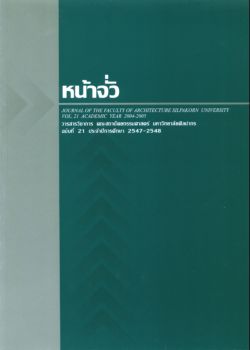ระบบนิเวศกับการวางผังหมู่บ้านพื้นถิ่นของไทเขินเชียงตุง
Keywords:
หมู่บ้านพื้นถิ่น, น้ำเหมืองบ้าน, ชุมชนบุพกาล, การจัดการน้ำ, Vernacular village, Village water way, Ancient community, Water managementAbstract
การศึกษาความสัมพันธ์ระหว่างระบบนิเวศและวิถีชีวิต และสภาพของหมู่บ้านกลุ่มชาติพันธุ์ไท ทั้งในประเทศไทยและนอกประเทศไทยได้พบว่า การศึกษากลุ่มชาติพันธุ์ไทนอกประเทศสามารถให้ความเข้าใจความสําคัญของชุมชนและหมู่บ้านได้แจ่มชัดกว่าในประเทศไทยเพราะชุมชนทุกแห่งยังเก็บรักษาลักษณะดั้งเดิมไว้ได้มากการนับถือธรรมชาติและบรรพบุรุษยังคงอยู่อย่างชัดเจน โดยเฉพาะในพื้นกลุ่มชาติพันธุ์ไทเขินเชียงตุง ในบทความนี้เห็นได้ชัดว่า ผังกายภาพของหมู่บ้านสะท้อนให้เห็นแก่นของวัฒนธรรมสามประการ คือ การเคารพในธรรมชาติที่เชื่อมโยงจิตวิญญาณกับระบบนิเวศ การเคารพบรรพบุรุษและเครือญาติ และการพึ่งพาตนเองในระบบของชุมชนที่ยืนอยู่บนขาของตนเอง
Ecology and Layout of Tai-Khoen Villages in Chieng Tung
From comparative study of houses and villages of different Tai ethnic groups in and outside of Thailand with emphasis on the study of cultural ecology, way of life, and physical appearance of the villages, it was found that case studies of the Tai ethnic groups outside Thailand can provide a clearer understanding of the importance of local communities and their villages due to the fact that the majority of them still retained their traditional values. The study of the influence of ecology on the layout of the villages revealed 3 important cultural factors that are the bases of their lives; these are the respect for nature that tightly binds humanity and ecology, the high regards for their ancestors, and the endeavour to create a self-sustaining community.





